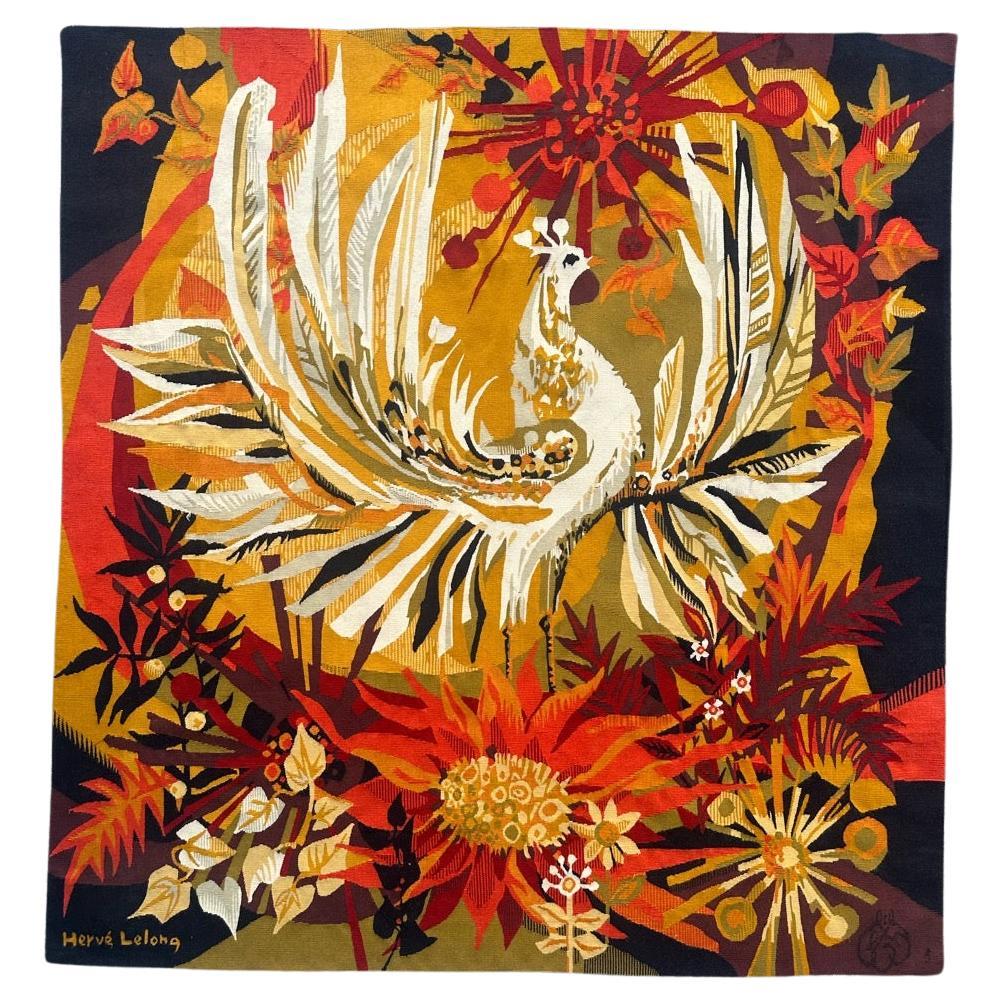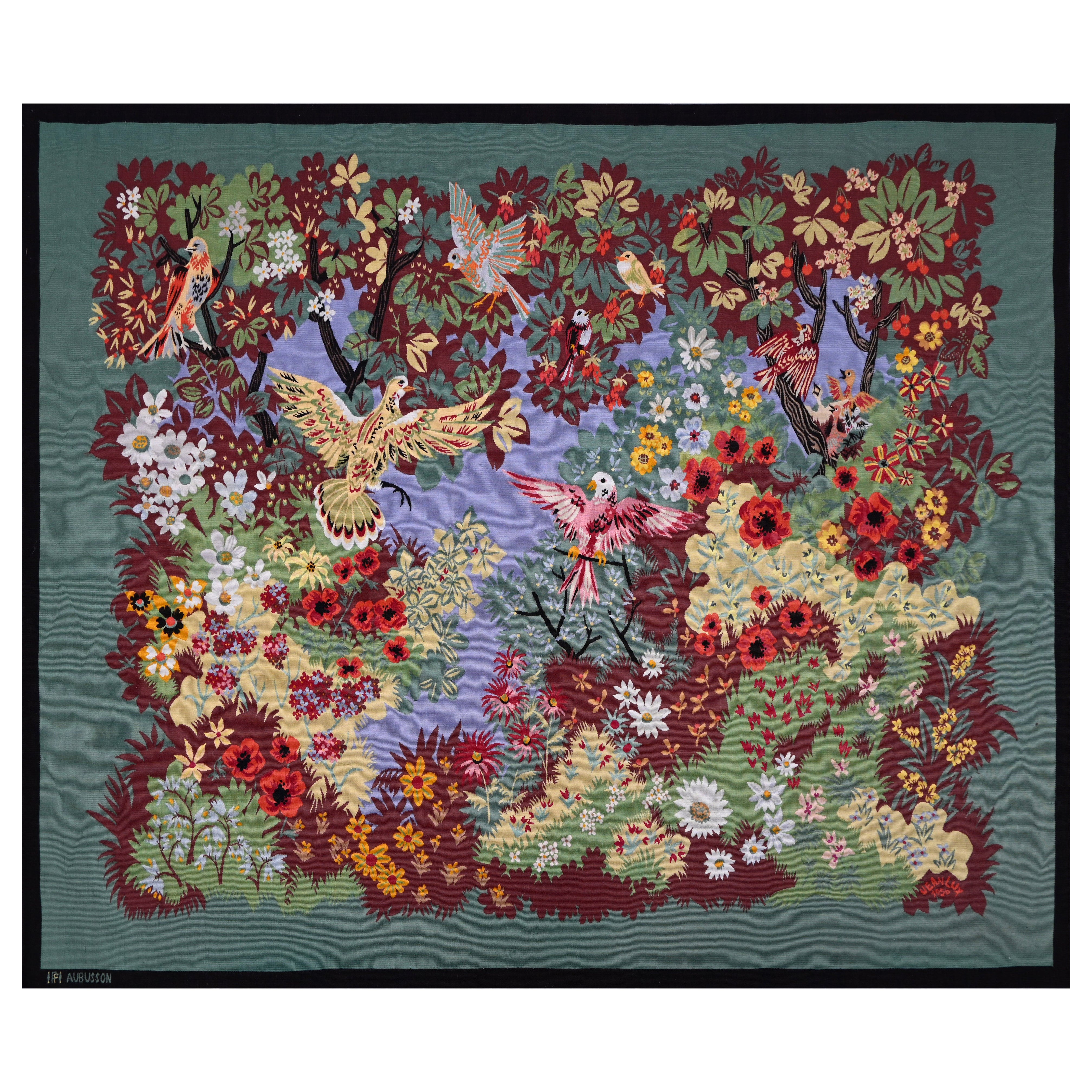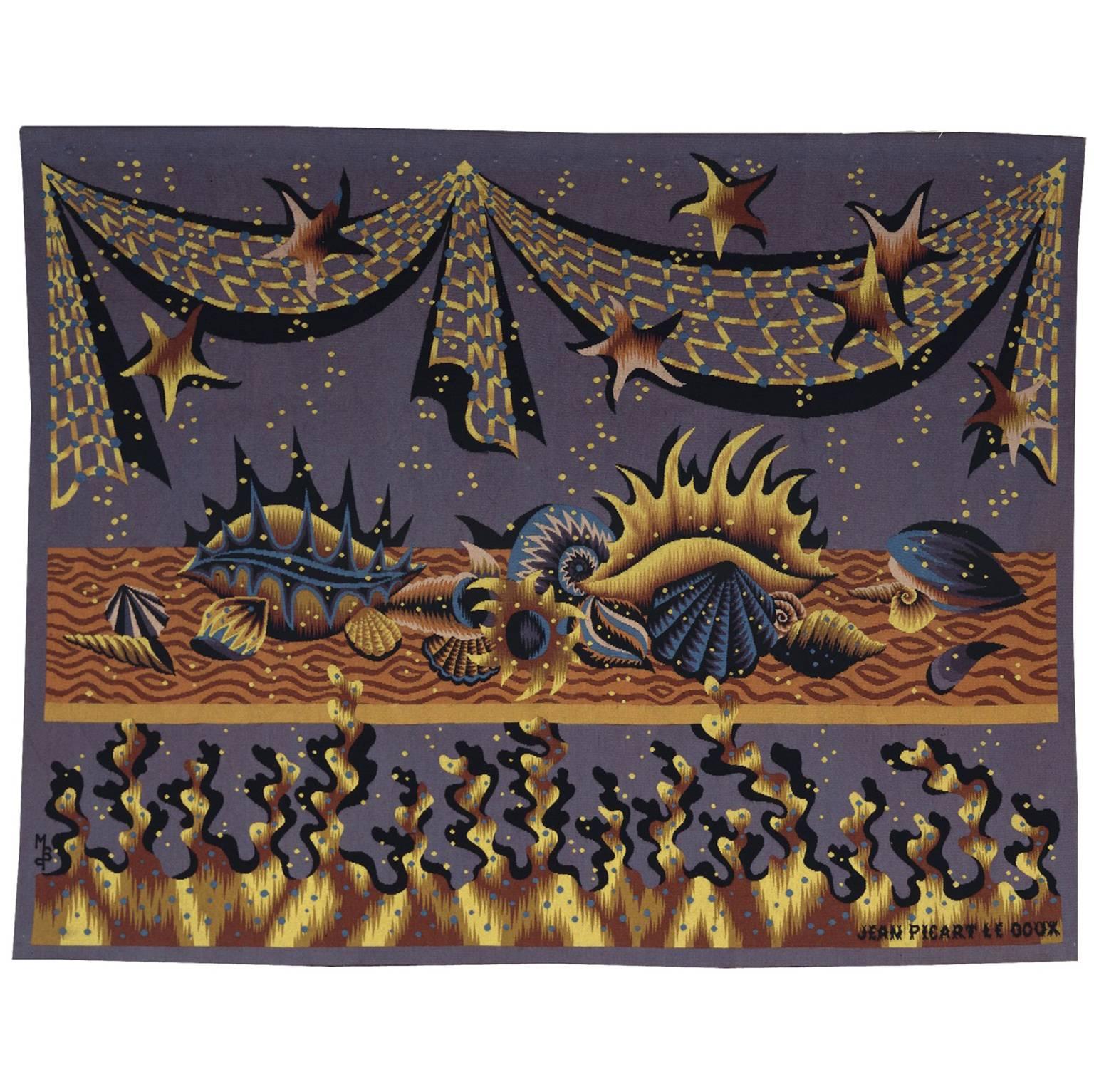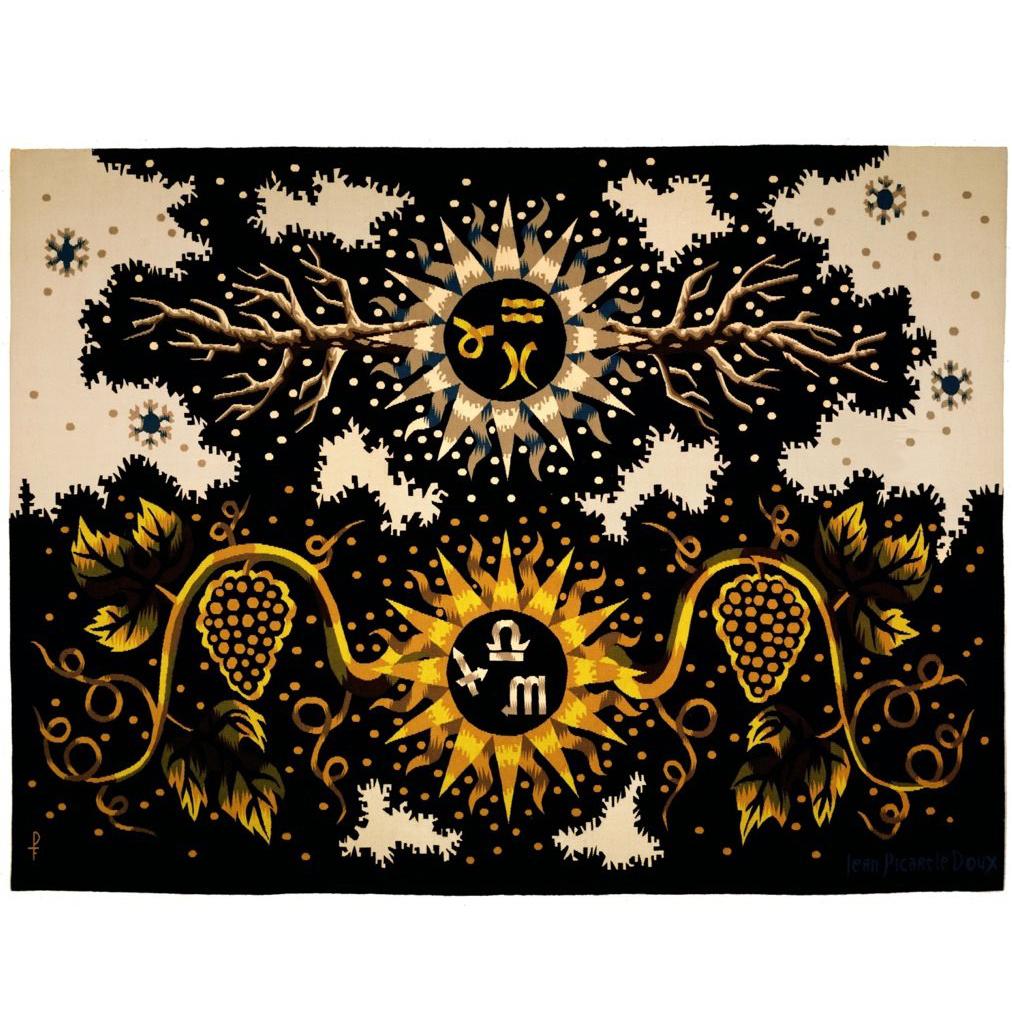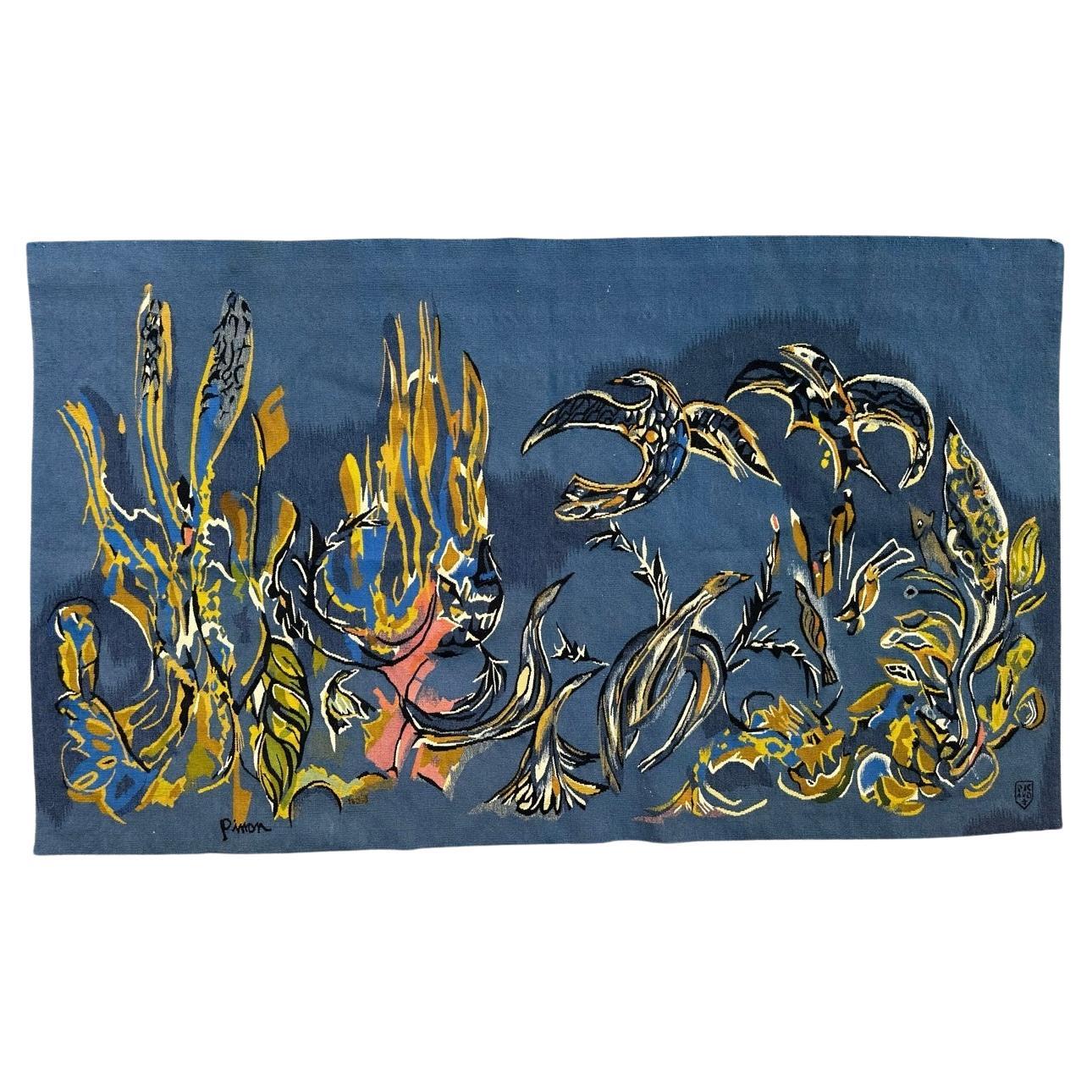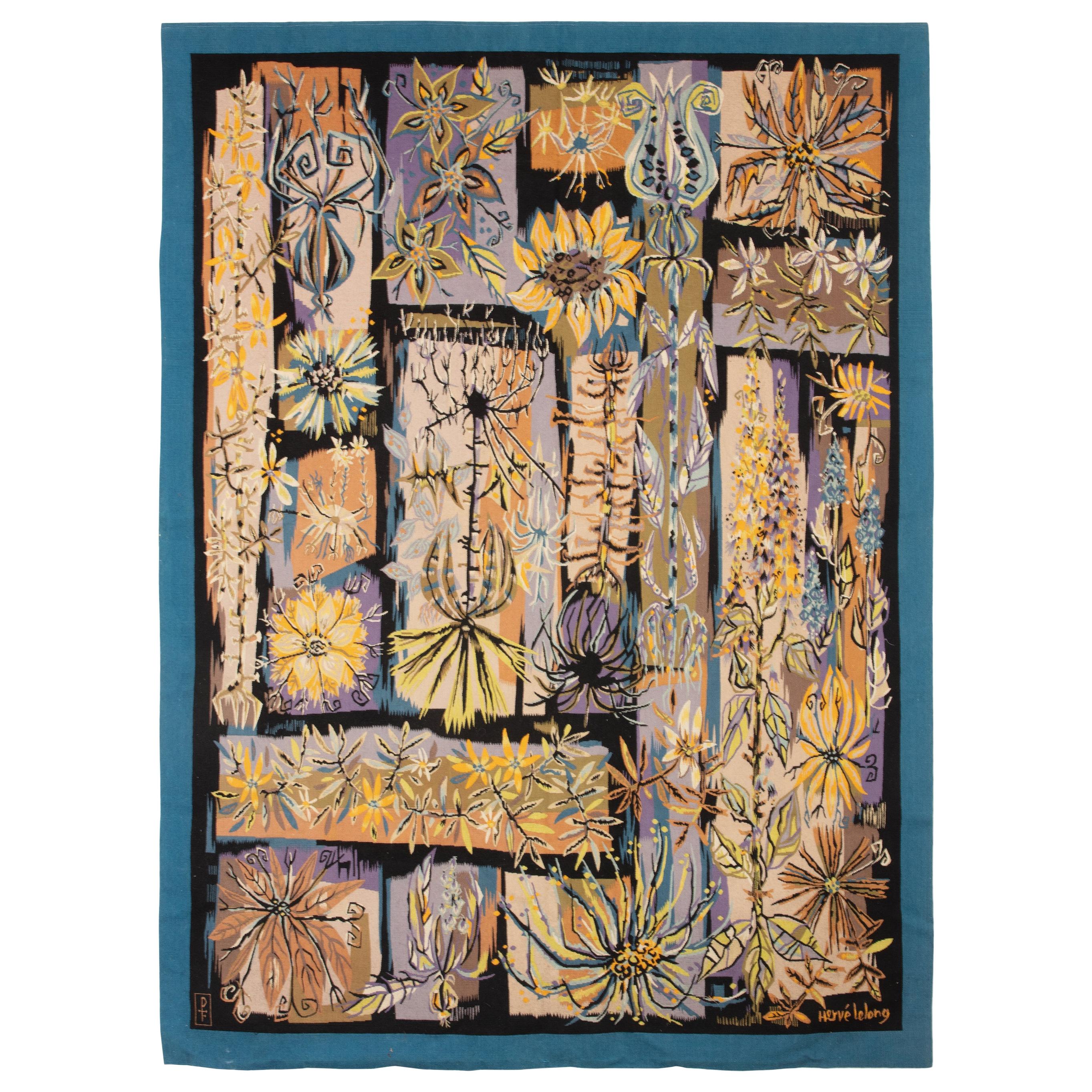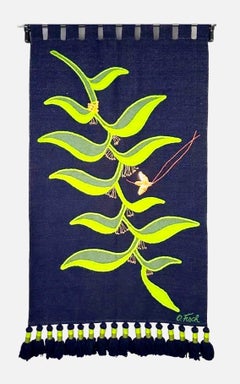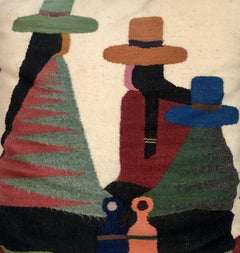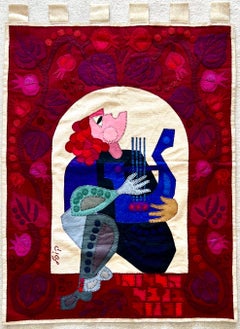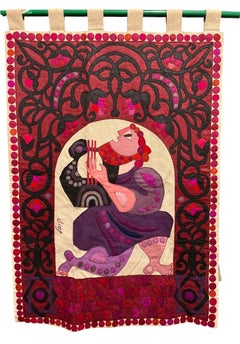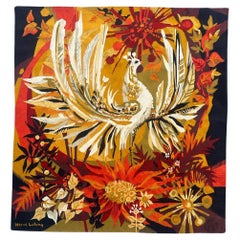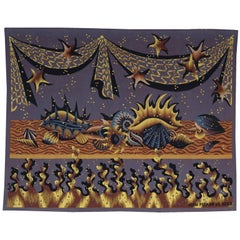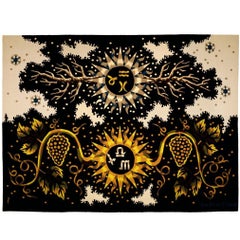Items Similar to Art Deco French Modernist Handmade Aubusson Gobelin Tapestry Jean Picart Le Doux
Want more images or videos?
Request additional images or videos from the seller
1 of 20
Jean Picart Le DouxArt Deco French Modernist Handmade Aubusson Gobelin Tapestry Jean Picart Le Douxc.1950's
c.1950's
$8,500
£6,492.43
€7,424.03
CA$12,083.26
A$13,252.39
CHF 6,930.71
MX$160,125.22
NOK 86,960.71
SEK 81,970.99
DKK 55,409.36
About the Item
Jean Picart Le Doux, French (1902 - 1982)
"Au Rendez Vous Des Oiseaux"
Larger handmade wool Aubusson tapisserie
Produced by Maison M. Berthaut Aubusson Atelier, France. Signed Lower left corner woven with firm's monogram and lower right with artists full name.
Bears stitched label attached en verso.
Original documents included with the lot.
Measures 71-1/2" x 50".
Jean Picart Le Doux, born in Paris in 1902 and died in 1982, was a French painter and painter-cartonnier the revival of contemporary flat weave tapestry. He is the son of the painter Charles Picart Le Doux (1881-1959). His first tapestry dating from 1943 after winning the Grand Prix of the theater poster exhibition in the imaging. He met Jean Lurcat and, and Marc Saint-Saëns,and together they founded the Association of painters cardboard tapestry in 1947. In 1950, he comes up with the idea for the Alliance Graphique Internationale, during the meeting with exhibitors of an exhibition of their work in Basel, Switzerland along with two other French designers Jean Jacques Colin and Nathan, and two Swiss graphic designers, Fritz Buhler and Donald Brown. AGI is officially founded November 22, 1952 and Picart Le Doux will be its first president.
Picart Le Doux was a French artist noted for his role in the revival of contemporary hand woven Aubusson tapestry. Picart Le Doux's first tapestry cartoon was a diptych entitled The Four Seasons. Made in 1943 and hand woven in 1945 at the Pinton workshops in Aubusson and was intended for the ocean liner La Marseillaise. He worked mainly with the Ateliers Berthaut and Hamot in Aubusson and produced some cartoons for the Manufacture nationale des Gobelins. His style is heavily influenced by Art Deco and French Modernism. He also worked as an illustrator and did Illustrations in the deluxe edition The veins of the Earth by Jean Cocteau Death of the Eagle, Paul Eric The Child and the Enchantments, illustration of the book presentation of this lyrical fantasy into two parts by Colette and music by Maurice Ravel, French edition of Broadcasting. The Bestiary, or procession of Orpheus by Guillaume Apollinaire was illustrated with color lithographs on behalf of Les Bibliophiles de France (1962). Prints the logo of the sower to the Larousse publishing house used between 1955 and 1970, models of twenty-three Precancels stamps of France, issued between 1983 and 19881. Lithographs Splendor marine The hare and the tortoise for the Fables of La Fontaine ed. Jaspard, Polus and Co. Place de la Concorde. Tableware First Class Air France, by Jean Picart le Doux. Dishes used until 2008 on aircraft Air France (Business Class, First Class). (Source: Air France, "Air France, sky objects," Michel Fraile, Editions Ouest-France 2003)
influential and world famous tapestry designer - Jean Picart Le Doux was influenced by the Surrealist movement in the 1930s and 40s and produced a series of paintings inspired by Rene Magritte and others. He met painters such as Pablo Picasso, Henri Matisse, Paul Cezanne and Renoir; He participated in several expositions with Raoul Dufy, Marcoussis, Jean Lurcat, Jean Cocteau, Laglenne and others. He is buried in the Père-Lachaise cemetery
- Creator:Jean Picart Le Doux (1902 - 1982, French)
- Creation Year:c.1950's
- Dimensions:Height: 71.5 in (181.61 cm)Width: 50 in (127 cm)
- Medium:
- Movement & Style:
- Period:
- Condition:minor age commensurate wear.
- Gallery Location:Surfside, FL
- Reference Number:1stDibs: LU38213144382
About the Seller
4.9
Platinum Seller
Premium sellers with a 4.7+ rating and 24-hour response times
Established in 1995
1stDibs seller since 2014
1,811 sales on 1stDibs
Typical response time: 1 hour
- ShippingRetrieving quote...Shipping from: Surfside, FL
- Return Policy
Authenticity Guarantee
In the unlikely event there’s an issue with an item’s authenticity, contact us within 1 year for a full refund. DetailsMoney-Back Guarantee
If your item is not as described, is damaged in transit, or does not arrive, contact us within 7 days for a full refund. Details24-Hour Cancellation
You have a 24-hour grace period in which to reconsider your purchase, with no questions asked.Vetted Professional Sellers
Our world-class sellers must adhere to strict standards for service and quality, maintaining the integrity of our listings.Price-Match Guarantee
If you find that a seller listed the same item for a lower price elsewhere, we’ll match it.Trusted Global Delivery
Our best-in-class carrier network provides specialized shipping options worldwide, including custom delivery.More From This Seller
View AllVintage Handwoven Tapestry Wool Folk Art Rug Weaving Wall Hanging Olga Fisch
By Olga Fisch
Located in Surfside, FL
Olga Fisch ( American 1901-1990)
Hummingbird and Pendant Flower, hand woven and stitched wool and sequins, signed lower right.
Dimensions: 58 x 32 in.
Olga Fisch was born in Hungary, studied in Germany and lived in Morocco and Ethiopia before receiving asylum as a Jewish refugee in Ecuador in 1939. For her Indian-inspired designs, Mrs. Fisch uses natural black and white sheep...
Category
20th Century Folk Art More Art
Materials
Wool
Vintage Handwoven Tapestry Wool Folk Art Rug Weaving Pillow or Wall Hanging
By Olga Fisch
Located in Surfside, FL
Olga Fisch was born in Hungary, studied in Germany and lived in Morocco and Ethiopia before receiving asylum as a Jewish refugee in Ecuador in 1939. For her Indian-inspired designs, Mrs. Fisch uses natural black and white sheep...
Category
1950s Folk Art More Art
Materials
Wool
Wool Felt Applique Israeli Folk Art Signed Tapestry Kopel Gurwin Bezalel School
By Kopel Gurwin
Located in Surfside, FL
This depicts KIng David reciting Psalms, Hallelujah in Hebrew
Kopel Gurwin (Hebrew: קופל גורבין) (1923–1990) was an Israeli tapestry wall hanging, painter and graphic artist.
Kopel (Kopke') Gurwin (Gurwitz) was born and raised in Vilna, the capital of Lithuania. He spoke Yiddish at home, but simultaneously studied Hebrew at their school which was part of the Tarbut educational network. Kopel was active in the Hashomer Hatzair youth movement. In the 1930s, as a teenager, Kopel helped his parents with the home finances by working in a suit workshop, there he first encountered the art of sewing.
With the outbreak of the Second World War and the German invasion of Vilna, the Jews were imprisoned in camps and ghettos. Kopel and his brother Moshe were separated from their parents and were put to work in coal mines and peat. Kopel's parents were taken to the Stutthof Nazi concentration camp where they died of typhus within a month of each other. Kopel's 12-year-old sister Chava was turned over to the Germans by a Polish family and murdered.
The brothers were arrested by the Germans, but were saved thanks to the connections of Nina Gerstein, Kopel's drama teacher. They hid in an attic until they were discovered, fled and moved to Riga, where they were caught and sent to the Stutthof concentration camp where they were imprisoned until the end of the war. They were put to work maintaining and cleaning trains and took part in one of the death marches. In July 1946, Kopel and Moshe sailed to Helsingborg, Sweden, as part of operation "Folke Bernadotte", in which Sweden took in ill survivors for rehabilitation. Once he recovered, Kopel worked in a publishing house and later was appointed director of the local branch of the Halutz movement.
In 1950 Kopel and Moshe made aliyah to Israel. Kopel worked as a survey for the Survey of Israel Company. In 1951, he enlisted to the Communication Corps and served as a military draftsman. There he won first prize for the design of the front cover of the Communication Corps bulletin.
With his discharge from the army at 29 he started studying drawing and graphics at the Bezalel Academy of Arts and Design in Jerusalem. Among his teachers were Isidor Ascheim, Shlomo Vitkin, Yossi Stern and Jacob Steinhardt. At the end of his first year of study, Kopel won the Reuben and Sarah Lif Excellence Award in written studies. During his studies he also won additional prizes: In 1956 he won first prize from the Lethem Foundation in California for poster design. Later the same year, Kopel won the Hermann Struck prize for his drawing on the theme of Jerusalem.
In 1957 he won an additional first prize from the Lethem Foundation and second place from the printing company Ortzel for a drawing for a Jewish New Year greeting card. In 1958 he won first prize in a competition to design a poster for Tel Aviv's jubilee.
Two years later he won three other awards: First and third prize for designing a poster for Israel Independence Day, celebrating 12 years of the State of Israel.
Also that year Kopel won first prize for a poster to mark the 25th Zionist Congress.
In 1964 he entered the Independence Day poster competition on the theme of aliyah and won first and second prize. Four years later he again entered the competition on the theme of 20 years of Israel's independence and won first prize. The poster was styled like a Holy Ark curtain with two lions and a menorah at its centre. This poster appeared on the cover of the famous book Jewish Art and Civilization, edited by Geoffrey Wigoder as well as the record Voices of 20 Years, 1948-1968, edited by Yossi Godard. In April 1971 he won first prize in the Independence Day poster competition for the fourth time.
Kopel's Folk Art tapestry won the Israeli Independence Day Poster Contest in 1968
With the completion of his studies at Bezalel Kopel moved to Tel Aviv and was hired by Shmuel Grundman's graphics and design studio. Grundman took him to Europe with him to design and supervise the construction of Israeli exhibition pavilions. During his time at Grundman's he discovered the fibrous felt from which he produced most of his wall hangings. At the 1964 Levant Fair exhibition he used felt stuck onto wooden panels for the first time.
The first felt wall hanging that Kopel produced was intended for the American Cultural Centre in Jerusalem and its theme was the United States Declaration of Independence. The wall hanging, which measured 2.85 X 1.85 meters, was stuck on a wooden panel. Kopel ordered rolls of felt from France and began work on wall hangings based on bible stories. He used a needle, hand sewing small even stitches with black embroidery thread which framed and highlighted every detail in the work, as well as using appliqué. The interior designer, Alufa Koljer-Elem, introduced him to Ruth Dayan who managed the shop Maskit in September 1967 he opened his first solo exhibition at the Maskit 6 gallery, in which 12 wall hangings were displayed.
In light of the exhibition at Maskit 6, Meira Gera, the director of artistic activity at the America-Israel Cultural Foundation, organized an additional exhibition of his works at the foundation's exhibition hall in New York City. The exhibition sparked immense press interest, and was also displayed for a few months at the New York Jewish Museum, from where it travelled throughout the United States.
Followed by the exhibition at the Delson-Richter gallery in Old Jaffa, which was later also exhibited at the Jerusalem Theatre.
Kopel's tapestry "The Time for Singing has Arrived" was printed on a UNICEF greeting card in 1978 and again in 1981.
The Israeli Philatelic Service issued three stamps based on three of Kopel's holy ark curtains and one stamp based on an Independence Day poster he designed.
Kopel's creations decorate a large number of synagogues, public buildings, hotels and private collections which were purchased in Israel and around the world. They have decorated, among others, the walls of the King David Hotel in Jerusalem, the VIP room at Ben Gurion Airport, the Kfar Saba theatre and the Plaza Hotel in Tel Aviv.
Israel has had a Vibrant Folk Art, Naive art scene for a long time now artists like Israel Paldi, Nahum Guttman, Reuven Rubin had naive periods. The most well know of the strict naive artists are Shalom of Safed, David Sharir, Irene Awret, Gabriel Cohen, Natan Heber, Michael Falk and Kopel Gurwin.
Exhibitions:
1995 The Knesset Jerusalem
1988 Temple Beth Shalom Miami, Florida
1988 University of Jewish Studies Los Angeles
1987 Israel Congregation on the Northern Coast Chicago
1985 Jerusalem Theatre Jerusalem
1984 Tenafly New Jersey
1983 Horace Richter Gallery Old Jaffa
1974 Jerusalem Theatre Jerusalem
1974 Delson Richter Gallery Old Jaffa
1972 University of Jewish Studies Miami, Florida
1971 Jewish Museum New York
1970 Norman Gallery Canada
1970 Sharei Tzedek Congregation Winnipeg, Canada
1970 Gallery of the Year Los Angeles
1970 Gallery of the Year Scottsdale
1969 Gleeman Gallery Chicago
1969 Israel Congregation of the Northern Coast Chicago
1967 Maskit 6 Tel Aviv
Prizes:
1971 First Independence Day poster 1971, 23 yeaes of the State of Israel
1969 Second International Tel Aviv poster...
Category
20th Century Folk Art Mixed Media
Materials
Wool, Felt
Wool Felt Craft Applique Vintage Israeli Judaica Folk Art Tapestry Kopel Gurwin
By Kopel Gurwin
Located in Surfside, FL
This depicts King David playing the harp, along with a verse in Hebrew from the Psalms. all made by hand. woven and stitched. Vintage, original piece.
Kopel Gurwin (Hebrew: קופל גור...
Category
20th Century Folk Art Mixed Media
Materials
Wool, Felt
70's Large Colorful Abstract Expressionist Art Protis Tapestry Wool Wall Hanging
By Robert Freimark
Located in Surfside, FL
Art Protis Wall Tapestry
Robert Freimark (1922 - 2010)
Bob Freimark was active/lived in Ohio, California, Michigan. Robert Freimark is known for abstract expressionist painting, ...
Category
1970s Abstract Expressionist Mixed Media
Materials
Wool
Large Americana Folk Art Pictorial Hooked Rug Wool Wall Hanging Tapestry
By Trudi Shippenberg
Located in Surfside, FL
"Downtown Hartford"
Hooked rug tapestry, various landmark buildings in Hartford, Connecticut, congregate within composition, including capital building, Colt building, Wadsworth Mus...
Category
20th Century Folk Art Mixed Media
Materials
Fabric, Wool
You May Also Like
Very Beautiful modern art deco Aubusson Tapestry by Herve Lelong
Located in Saint Ouen, FR
Introducing a Stunning Mid Century Aubusson Tapestry from Tunisia!
We're delighted to present this exquisite Aubusson tapestry, meticulously crafted in Tunisia with the same method ...
Category
Mid-20th Century Tunisian Mid-Century Modern Tapestries
Materials
Wool, Cotton
$5,717 Sale Price
20% Off
Jean Lux (20th Century) French Aubusson Tapestry, Atelier Pinton - N° 1490
By Atelier Pinton
Located in Paris, FR
Artist: Jean Lux (20th Century)
Era: 20th Century
Style: Design 50s-60s
Condition: Perfect condition
Material: Wool
Width: 215 cm
Height: 170 cm
Depth: 0.5 cm
Located a stone's thro...
Category
20th Century French Modern Tapestries
Materials
Wool
Mid-Century Jean Picart Le Doux Aubusson Tapestry
By Jean Picart Le Doux
Located in New York, NY
Tapestry was designed by Jean Picart LeDoux (1902-1982) and entitled "La Table aux Coquillages" (Table with Shells). It was hand woven at the Atelier Braquenie & Cie in Aubusson Fra...
Category
Mid-20th Century French Mid-Century Modern Tapestries
Materials
Wood, Tapestry
Price Upon Request
Jean Picart Le Doux Mid-Century Aubusson Tapestry
By Jean Picart Le Doux
Located in New York, NY
Mid-Century Aubusson tapestry designed by Jean Picart Le Doux (1902-1982) and handwoven at Atelier Pinton in Aubusson France. Woven in the mid-1960s, entitled "Autumn-Hiver", it depi...
Category
Mid-20th Century French Mid-Century Modern Tapestries
Materials
Wool, Tapestry
Very Beautiful modern Aubusson Tapestry by Pinon
Located in Saint Ouen, FR
Introducing a Stunning Mid Century Aubusson Tapestry from French painter (jacques pinon 1927-2018) & woven in workshops of raymond picard at aubusson
We're delighted to present th...
Category
Mid-20th Century French Mid-Century Modern Tapestries
Materials
Wool, Cotton
$5,044 Sale Price
20% Off
Sublime Aubusson Tapestry - Pinton Frères - Signed by Hervé Lelong
By Hervé Lelong
Located in New York, NY
-Sublime Aubusson tapestry signed by Hervé Lelong
-Dimensions: 228 x 173 cm
-Year: 1960s
-Manufacture: Frères Pinton, Aubusson, France
-Condition: Perfect
Category
Vintage 1960s French Aubusson Tapestries
Materials
Wool
More Ways To Browse
Vintage Theater Poster
Gobelin Tapestry
Gobelins Tapestries
Place De La Concorde
Modern Aubusson Tapestry
Vintage Grand Prix Posters
Tapestry Flat Weave
Aubusson Signed
Modernist Tapestry
Paul Child
Gobelins French Tapestry
French Tapestry Gobelins
Fritz Buhler
Jacqueline Au Chevalet
Jim Mcdonough
Jon Imber
Julius Evola
Kaws Accomplice
